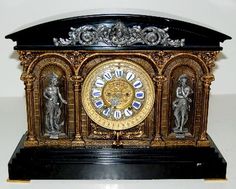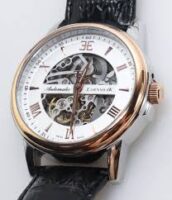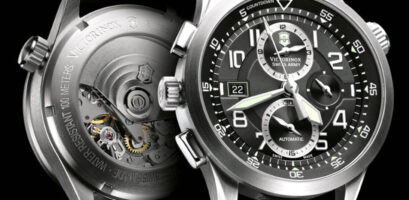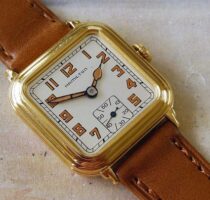









1844 – The Ansonia Brass Company is formed by Anson Green Phelps who became one of the great mercantile capitalists of his time.
Connecticut’s Naugatuck River Valley is rich in clock history, containing such places (with the older name in brackets) as: Winsted (Winchester), Torrington (Wolcottville), Thomaston (Plymouth Hollow), Waterbury (Mattituck), Naugatuck (Salem Bridge), and Ansonia on the east bank nine miles north west of New Haven. The falls in the river provided an excellent source of water power causing industry to locate here.
Anson Green Phelps was born to an old Connecticut family, he was orphaned at age ten, and soon after became a saddlemaker’s apprentice. He later moved to Hartford and went into business for himself as a merchant and a shrewd trader. He bartered saddles for cotton from South Carolina and then sold the cotton in New York. With the proceeds from the cotton sales he purchased dry goods to sell back in his Hartford store.
Anson Green Phelps moved to New York at age 31 to joined forces with another Connecticut trader, Elisha Peck. As the firm of Phelps & Peck they exported Southern cotton to England and imported metals to New York in return, becoming New York’s largest metal importer of the time.
After his partnership with Peck dissolved, he formed the firm of Phelps, Dodge & Co. with two of his son-in-laws. Phelps, Dodge and Co. remained a leading New York metals importer. Located in southeastern Connecticut’s Naugatuck River Valley on the east bank of the river, nine miles from New Haven, the factory produced rolled brass for industrial uses. The city of Ansonia was originally part of a larger area called Derby. When the city was incorporated in 1889 it was named Ansonia in honor of Anson Phelps.
1850 – The Ansonia Clock Company is formed as a subsidiary of the Ansonia Brass Company by Phelps and two Bristol, Connecticut clockmakers, Theodore Terry and Franklin C. Andrews.
The above resolution and sale on November 16, 1854 ended the original Ansonia Clock Company and for the 15 years following the fire, the history of clock manufacture at Ansonia is more difficult to follow. The parent firm of Phelps, Dodge & Co. manufactured a few cased clocks, but largely made movements to sell to other firms. Very few Ansonia Clocks from this era are seen today and those that are usually have the “Ansonia Brass Company” label. A few clocks were also labeled “Ansonia Brass & Battery Company” during this period.
The business was reorganized on February 11, 1869 and clocks made during this time were labeled “Ansonia Brass & Copper Company”. Then on December 21, 1877, a joint stock corporation was formed at New York City adopting the original name, “Ansonia Clock Company”.
In April of 1879, the operation was moved to a new facility at Brooklyn, New York. However the factory at Ansonia was not completely shut down until around 1883. Tragically on October 27, 1880 fire once again claimed the Ansonia Clock company. A new factory was built on the same site, and by 1883 the entire manufacturing operation was centered in Brooklyn. The company had sales offices in New York, Chicago and London. By 1914 they were offering almost 450 different clocks; they are most noted for their iron-cased clocks.
In 1877 the clock company purchased a factory in New York, and moved most of its production there. Henry J. Davies of Brooklyn, himself a clockmaker, inventor and case designer, joins the newly reconstituted company as one of its founders. As President, he is thought to be largely responsible for the figurine clocks, swing clocks and other unusual and desirable novelties for which the Ansonia firm became known.
In 1879 the factory was moved to the present location, but it burned down the following year (note that the article refers to the neighborhood as South Brooklyn, its previous moniker). A far larger, 300,000 square foot factory complex was rebuilt on the site in 1880, and throughout the decade Ansonia employed 1,500 workers and could churn out 10,000 clocks and watches a day.
In 1904 the company had attempted to jump on “the dollar watch” bandwagon, perhaps as an ineffectual guard against the first hints of potential financial difficulties, (Ansonia clocks were not cheap.) The idea behind the dollar watch was to make it in the same manner as a cheap clock. This concept bore little resemblance to the traditional, intricate style that went into the handcrafted watch. It did not pan out. Instead, designers turned to the tourbilion watch, concocted by the French genius, Breguet. Watches are difficult timekeepers due to the unstable positions they are likely to fall into. Breguet’s watch had a turning escapement which minimized these errors in accuracy. American designers went one step further, allowing the entire movement to rotate inside the case. The Ansonia Company produced a similar non-jeweled model. They sold millions of these inexpensive watches in the two and a half decades before they went out of business; an interesting comparison to the scrolled elaborate clockwork the Ansonia collector is familiar with.
Unfortunately these high times were not to last. By 1920 they were offering only 136 clocks and 9 watches and by 1927 they only offered 47 clocks and 3 watches. In July of 1929 the factory was sold to the Russian purchasing agent and the entire operation was moved to Moscow in the summer of 1930. The Ansonia trademark has been used in the last few decades by a Lynwood, Washington sales operation on imported clocks.
The Ansonia Company was best known for its decorative imitation gold, and ornate novelty clocks. Petulant cupids and angels, deep thinkers, athletes, babies, and languid ladles drape and adorn the ornamental designs, that characterize the name and products of Ansonia.
The factory complex was home to light industry and sweatshops until the 1970s, and in 1982 work began to convert the buildings into loft apartments. Today the old factory is a 71-unit co-op.
Please remember that this is an unofficial account of the history of this company, Should you happen to find any mistakes with our information then please let us know at



